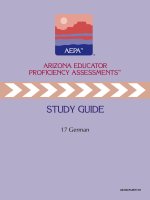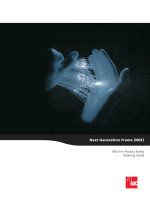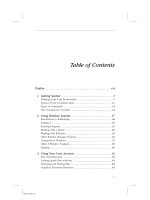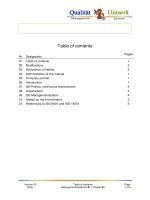TABLE OF CONTENTS
Bạn đang xem bản rút gọn của tài liệu. Xem và tải ngay bản đầy đủ của tài liệu tại đây (308.54 KB, 23 trang )
™
TMTM
AZ-SG-FLD017-01
17 German
Readers should be advised that this study guide, including many of the
excerpts used herein, is protected by federal copyright law.
Copyright © 2005 by National Evaluation Systems, Inc. (NES®)
"AEPA," "Arizona Educator Proficiency Assessments," and the "AEPA" logo are trademarks of
the Arizona Department of Education and National Evaluation Systems, Inc. (NES®).
"NES®" and its logo are registered trademarks of National Evaluation Systems, Inc.™
TM
TABLE OF CONTENTS
Field 17: German
PART 1: G
ENERAL
I
NFORMATION
A
BOUT THE
AEPA
AND
T
EST
P
REPARATION
A
N
O
VERVIEW OF THE
AEPA........................................................................................... 1-1
Test Development Process
Characteristics of the AEPA
Test Administration
How AEPA Test Scores Are Computed and Reported
H
OW TO
P
REPARE FOR THE
T
ESTS
................................................................................... 1-3
Study the Test Objectives
Focus Your Studies
Identify Resources
Develop Study Techniques
Answer the Practice Questions
Review the Sample Answer Sheet and Written Response Booklet
Test Directions
Sample Answer Sheet
Sample Written Response Booklet
W
HAT TO
E
XPECT THE
D
AY OF THE
T
EST
........................................................................ 1-12
The Morning of the Administration
At the Test Site
S
AMPLE
T
EST
O
BJECTIVES AND
Q
UESTIONS
.................................................................. 1-13
Organization of the Test Objectives
Question Formats and Strategies
Selected-Response-Question Formats
Performance Assignment Formats
Evaluation of the Sample Written Performance Assignment Response
PART 2: F
IELD
-S
PECIFIC
I
NFORMATION
I
NTRODUCTION
................................................................................................................. 2-1
T
EST
O
BJECTIVES
.............................................................................................................. 2-2
P
RACTICE
Q
UESTIONS
...................................................................................................... 2-6
A
NSWER
K
EY
..................................................................................................................... 2-19
S
TUDY
G
UIDE
O
RDER
F
ORM
TM
PART 1:
GENERAL INFORMATION ABOUT
THE AEPA
™
AND TEST PREPARATION
Part 1 of this study guide is contained in a separate PDF file. Click the link below to view or
print this section:
General Information About the AEPA and Test Preparation
Arizona Educator Proficiency Assessments Study Guide
2-1
TM
PART 2:
FIELD-SPECIFIC INFORMATION
Field 17: German
I
NTRODUCTION
This section includes a list of the test objectives, practice questions, and an answer key for the selected-
response questions.
Test objectives. As noted earlier, the test objectives are broad, conceptual statements that reflect the
knowledge, skills, and understanding an entry-level educator needs to practice effectively in Arizona schools.
The list of test objectives for each test field is the only source of information about what a specific test will
cover and therefore should be studied carefully.
Practice questions. The practice selected-response questions and practice performance assignments included
in this section are designed to give you an introduction to the nature of the questions included in the AEPA
tests. The practice questions represent the various types of questions you may expect to see on an actual test;
however, they are not designed to provide diagnostic information to help you identify specific areas of
individual strengths and weaknesses or to predict your performance on the test as a whole.
When you answer the practice questions, you may wish to use the sample answer sheet and sample Written
Response Booklet provided in Part 1 to acquaint yourself with these materials. Use the answer key located
after the practice questions to check your answers. Sample responses are provided immediately following
each written performance assignment. The sample responses in this guide are for illustrative purposes only.
Your written response should be your original work, written in your own words, and not copied or
paraphrased from some other work.
To help you identify how the test objectives are measured, the objective statement to which the question
corresponds is listed in the answer key. When you are finished with the practice questions, you may wish to
go back and review the entire list of test objectives and descriptive statements for your test field.
2-2
Arizona Educator Proficiency Assessments Study Guide
TEST OBJECTIVES
Field 17: German
SUBAREAS:
1. Listening Comprehension
2. Reading and Vocabulary
3. Language Structures
4. Cultural Understanding
5. Foreign Language Methodology
6. Written Expression
7. Oral Expression
LISTENING COMPREHENSION
0001 Derive essential information from oral messages in everyday situations.
For example: demonstrating understanding of the main idea or details in a spoken passage, a
telephone message, a public address announcement, a sequence of steps described in a set of oral
directions, a stated cause or effect of a situation described in an oral message, a question or
comment likely to be encountered in a social situation, or a request for information.
0002 Infer meaning from oral communications.
For example: characterizing the tone, mood, or point of view of one or more speakers; determining
a relationship (e.g., cause-and-effect) implied but not stated in an oral communication; and
determining the social context of a spoken exchange or the relationship between speakers.
READING AND VOCABULARY
0003 Demonstrate understanding of the literal content of a variety of authentic materials.
For example: analyzing a passage to determine the stated main idea; identifying an accurate
summary; discerning details regarding character, setting, or events described in a passage; and
analyzing a passage to determine the sequence of events.
0004 Apply skills of inference and interpretation to a variety of authentic materials.
For example: discerning implied cause-and-effect relations in a passage; and determining an
author's assumptions, purpose, or point of view in a passage.
0005 Interpret and compare literary texts representing various writers, periods, forms, styles, regions, and
cultural contexts.
For example: drawing conclusions about setting, character, historical period, or cultural context
from information provided in a passage; interpreting figurative language (e.g., metaphors, similes) in
a literary passage; comparing two passages in terms of style, form, or theme; and recognizing
features of literary styles associated with well-known writers from various periods, regions, and
cultures.
German
Arizona Educator Proficiency Assessments Study Guide
2-3
0006 Select words, phrases, or sentences (including idiomatic usages) to complete passages in German.
For example: determining appropriate language for travel situations (e.g., arranging for lodging,
booking tickets for a group); determining appropriate language for social situations (e.g., canceling
an appointment, expressing a compliment); determining appropriate language for everyday
transactions (e.g., shopping, dining); and determining appropriate language for expressing attitudes,
opinions, and judgments.
LANGUAGE STRUCTURES
0007 Demonstrate understanding of the linguistic components of German.
For example: analyzing words, phrases, and passages that exemplify aspects of German phonology,
morphology, syntax, and semantics; and comparing linguistic elements of German and English.
0008 Transform sentences or passages in context according to given instructions.
For example: transforming a positive statement, question, or command to a negative one, or vice
versa; transforming the tense or mood of a sentence or passage; transforming a sentence or passage
from direct to indirect discourse, or vice versa; and combining two or more sentences into one
sentence that preserves the meaning of the original sentences.
0009 Analyze sentences to determine grammatically correct words or phrases to complete them.
For example: using the correct noun or pronoun form for a given context; using verb forms or
phrases as appropriate for a given context; using the appropriate modifying word or phrase to
complete a sentence; and using the appropriate subordinate clause to complete a sentence.
CULTURAL UNDERSTANDING
0010 Demonstrate understanding of the historical development, geographic features, and social characteristics
of German-speaking cultures.
For example: recognizing the role of major historical events, figures, and movements in the
development of German-speaking cultures; relating natural geographic features (e.g., climate,
location, natural resources) of German-speaking nations to the economies of these nations
(e.g., mineral and agricultural products); identifying major institutions (e.g., educational systems,
systems of government) and characteristic features of daily life in German-speaking societies; and
recognizing features of U.S. institutions or culture that originated in German-speaking societies.
0011 Demonstrate understanding of literature, the nonliterary arts, science, and technology as aspects of
German-speaking cultures.
For example: identifying the significance of major movements, figures, and works of literature
written in German; understanding the characteristic forms and elements of the visual arts and music
of German-speaking cultures; recognizing scientific and technological achievements (historical or
contemporary) of German-speaking cultures; and analyzing the significance of historical and
contemporary interactions between German-speaking cultures and other cultures.
German
2-4
Arizona Educator Proficiency Assessments Study Guide
FOREIGN LANGUAGE METHODOLOGY
0012 Recognize current trends in foreign language methodology.
For example: recognizing methods and terminology that conform to the “5 Cs” of the foreign
language national standards (communication, culture, comparisons, connections, communities),
such as Total Physical Response (TPR), Comprehensible Input, cooperative learning, and authentic
materials.
0013 Apply a variety of current foreign language methodologies used in a classroom setting.
For example: determining an appropriate methodology in a given instructional situation
(e.g., introducing and expanding vocabulary, using grammatical structures in context, facilitating
the development of all language skills and cultural understanding).
WRITTEN EXPRESSION
0014 Write well-organized German prose that is appropriate in style and diction for given audiences, purposes,
and occasions and that communicates effectively through use of a range of vocabulary, idiomatic
expressions, and simple and complex linguistic constructions.
For example: writing a letter describing your community to a partner teacher for an exchange
program for students in a German-speaking culture; or writing a short essay for an application to a
program of study in a German-speaking country.
ORAL EXPRESSION
0015 Construct connected oral discourse in German that communicates effectively and that demonstrates
command of a range of vocabulary, idiomatic expressions, simple and complex language structures,
pronunciation, and appropriateness of language.
For example: narrating a personal experience to a professional colleague; expressing and
supporting an opinion on a topic of current interest; or responding to a hypothetical situation
(e.g., a traffic accident) by explaining or describing events or by requesting assistance.
German
Arizona Educator Proficiency Assessments Study Guide
2-5
DISTRIBUTION OF SELECTED-RESPONSE ITEMS ON THE TEST FORM
1
5
4
Subarea
Approximate Percentage
of Selected-Response
Items on Test Form
16%
29%
22%
16%
16%
*
*
*This chart represents the distribution of multiple-choice items only
and does not include the writing and speaking components.
2
3
1. Listening Comprehension
2. Reading and Vocabulary
3. Language Structures
4. Cultural Understanding
5. Foreign Language Methodology
6. Written Expression
7. Oral Expression
![SECTION 10: FOUNDATIONS TABLE OF CONTENTS [TO BE FURNISHED WHEN SECTION IS FINALIZED]](https://media.store123doc.com/images/document/12/pt/qq/medium_dY8TJTm9cv.jpg)
![SECTION 10 FOUNDATIONS TABLE OF CONTENTS [TO BE FURNISHED WHEN SECTION IS FINALIZED] - DRILLED SHAFTS](https://media.store123doc.com/images/document/13/pt/uy/medium_ifMhcWC9sw.jpg)
![SECTION 10 FOUNDATIONS TABLE OF CONTENTS [TO BE FURNISHED WHEN SECTION IS FINALIZED] - DRIVEN PILES](https://media.store123doc.com/images/document/13/pt/tw/medium_kD5W3NinOp.jpg)
![SECTION 10 FOUNDATIONS TABLE OF CONTENTS [TO BE FURNISHED WHEN SECTION IS FINALIZED] - EXTREME LIMIT STATES](https://media.store123doc.com/images/document/13/pt/gx/medium_dfhio1mCxD.jpg)
![SECTION 10 FOUNDATIONS TABLE OF CONTENTS [TO BE FURNISHED WHEN SECTION IS FINALIZED] - FOUNDATIONS](https://media.store123doc.com/images/document/13/pt/tw/medium_ixsYUu8nZ7.jpg)




